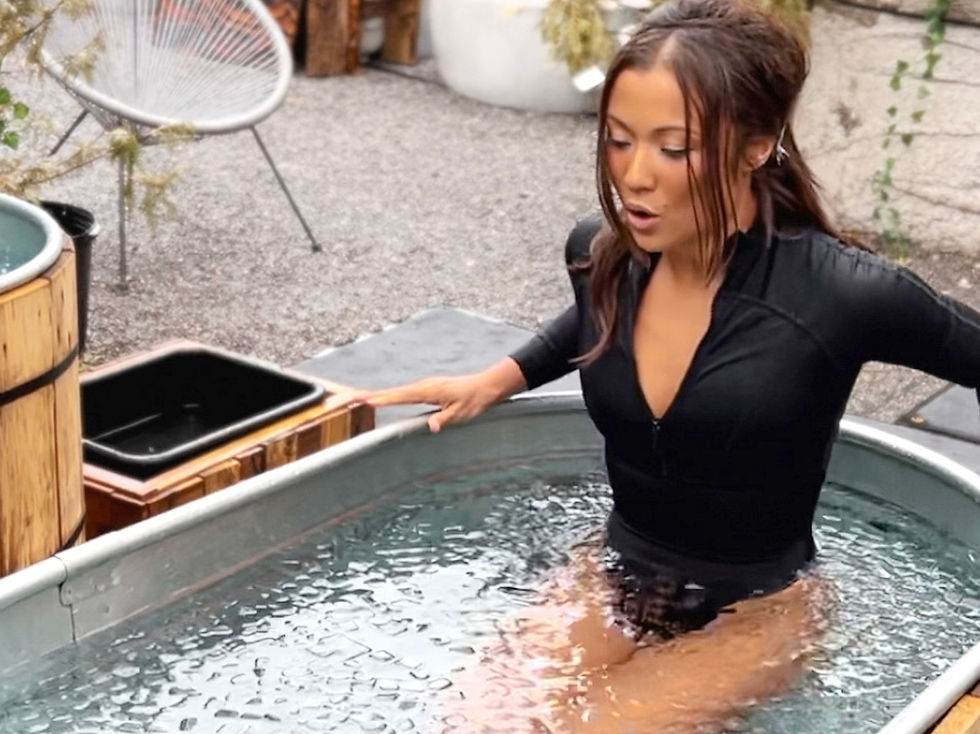Why Cold Exposure Starts With Your Breath
- Active Aqua

- Jun 16
- 3 min read
If you’ve ever jumped into an ice bath and instantly regretted it, odds are your breath got hijacked.
And if you’ve ever eased into that same water with presence and control, you already know the secret: the breath leads the body. It doesn’t just get you through the cold. It prepares you to meet it.
We recommend you start every plunge session the same way: with 10 to 15 minutes of focused breathwork. This is perhaps the most important part of the practice.
Your Nervous System Enters First
The moment cold water hits your skin, your body flips the emergency switch. Heart rate spikes. Breath shortens. Every signal says: escape. And if you go in without a plan, that’s exactly what your body will try to do.
But the breath gives you an edge. It bridges the gap between stress and stability. A steady inhale tells your brain: we’re safe. A long exhale tells your body: We’re staying.
Breathing is how you turn a stressor into a teacher. It’s how you meet discomfort without fear. It’s how you anchor attention in a place that can otherwise slip away in the first few seconds.
Let’s walk through the techniques that make that possible.
Box Breathing (4-4-4-4): The Reset Button
How to do it:
Inhale through your nose for 4 seconds
Hold for 4 seconds
Exhale for 4 seconds
Hold again for 4 seconds
Repeat
Why it works: Box breathing creates calm through rhythm. It downshifts your nervous system, evens out your heart rate, and quiets the noise in your head. It’s a perfect pattern to run just before stepping in. Steady, focused, composed.
Diaphragmatic (Belly) Breathing: Core Warmth from the Inside Out
How to do it:
Sit or lie down
Inhale through your nose and let your belly expand
Exhale slowly through your mouth or nose
Repeat for 3–5 minutes
Why it works: This is a foundational breathing exercise. Deep, diaphragmatic breathing increases oxygen saturation and warms your core from the inside out. It also retrains your body to breathe deeply under pressure, so when the cold hits, you’re less likely to gasp or panic.
Tummo-Inspired Breathing (Modified Wim Hof): Turn Up the Heat
How to do it:
Take 30–40 strong, deep breaths. Big inhale, relaxed exhale.
On the final breath, exhale fully and hold at the bottom
When the urge to breathe returns, inhale fully and hold for 10–15 seconds
Repeat for 2–3 rounds (Do not perform this while in the water.)
Why it works: This method activates heat, quickly. It raises internal energy and helps prime the body to tolerate cold exposure. It’s more activating than calming, so use it earlier in your prep, not right before getting in.
2:1 Exhale Ratio: The Panic Diffuser
How to do it:
Inhale through your nose for 3–4 seconds
Exhale through your mouth for 6–8 seconds
Repeat for 2–3 minutes
Why it works: The exhale is your built-in signal of safety. Doubling its length shuts down panic reflexes and locks you into a calmer baseline. This is a great technique to use just before entering the water or as a steady rhythm once you’re in.
Stack It. Feel the Shift.
You don’t need to pick just one. Try stacking them.
Start with two rounds of Tummo-inspired breathing to build heat. Shift into belly breathing for 3–5 minutes to ground and settle. Then finish with either box breathing or a few rounds of 2:1 exhales to dial in calm focus.
By the time you reach the edge of the tub, your body will be ready. Your mind will be quiet. Your breath will be your anchor.
The Real Practice Begins Before the Plunge
Cold exposure is mostly about awareness. The strongest people in the tub aren’t the ones who white-knuckle it. They’re the ones who breathe, soften, and stay present.
So before you step in, pause. Sit down. Close your eyes. Breathe with intention. Teach your nervous system that this isn’t an emergency; it’s a choice.
That’s how the practice begins to shift from shock to ritual.
Looking to get started?
Explore the full line of Active Aqua chillers and find the perfect fit for your DIY cold plunge today.




